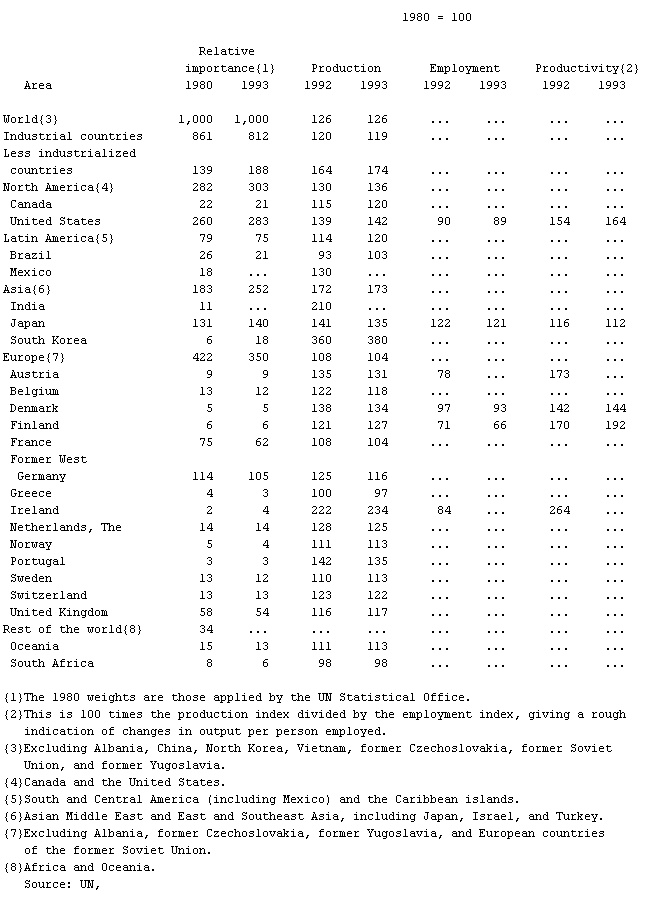- Index Numbers of Production, Employment, and Productivity in Manufacturing Industries, Table 1
-
▪ Table1980 = 100Relativeimportance{1} Production Employment Productivity{2}Area 1980 1993 1992 1993 1992 1993 1992 1993World{3} 1,000 1,000 126 126 ... ... ... ...Industrial countries 861 812 120 119 ... ... ... ...Less industrializedcountries 139 188 164 174 ... ... ... ...North America{4} 282 303 130 136 ... ... ... ...Canada 22 21 115 120 ... ... ... ...United States 260 283 139 142 90 89 154 164Latin America{5} 79 75 114 120 ... ... ... ...Brazil 26 21 93 103 ... ... ... ...Mexico 18 ... 130 ... ... ... ... ...Asia{6} 183 252 172 173 ... ... ... ...India 11 ... 210 ... ... ... ... ...Japan 131 140 141 135 122 121 116 112South Korea 6 18 360 380 ... ... ... ...Europe{7} 422 350 108 104 ... ... ... ...Austria 9 9 135 131 78 ... 173 ...Belgium 13 12 122 118 ... ... ... ...Denmark 5 5 138 134 97 93 142 144Finland 6 6 121 127 71 66 170 192France 75 62 108 104 ... ... ... ...Former WestGermany 114 105 125 116 ... ... ... ...Greece 4 3 100 97 ... ... ... ...Ireland 2 4 222 234 84 ... 264 ...Netherlands, The 14 14 128 125 ... ... ... ...Norway 5 4 111 113 ... ... ... ...Portugal 3 3 142 135 ... ... ... ...Sweden 13 12 110 113 ... ... ... ...Switzerland 13 13 123 122 ... ... ... ...United Kingdom 58 54 116 117 ... ... ... ...Rest of the world{8} 34 ... ... ... ... ... ... ...Oceania 15 13 111 113 ... ... ... ...South Africa 8 6 98 98 ... ... ... ...{1}The 1980 weights are those applied by the UN Statistical Office.{2}This is 100 times the production index divided by the employment index, giving a roughindication of changes in output per person employed.{3}Excluding Albania, China, North Korea, Vietnam, former Czechoslovakia, former SovietUnion, and former Yugoslavia.{4}Canada and the United States.{5}South and Central America (including Mexico) and the Caribbean islands.{6}Asian Middle East and East and Southeast Asia, including Japan, Israel, and Turkey.{7}Excluding Albania, former Czechoslovakia, former Yugoslavia, and European countriesof the former Soviet Union.{8}Africa and Oceania.Source: UN,
 Monthly Bulletin of Statistics.
Monthly Bulletin of Statistics. * * *
Universalium. 2010.
